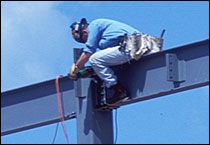MLUI / Articles from 1995 to 2012 / Unions Weigh in to Beat Back Sprawl
Unions Weigh in to Beat Back Sprawl
A new player on the Smart Growth block
October 27, 2002 |
Great Lakes Bulletin News Service
 | |
| MLUI Staff | |
| One important reason that union workers are joining the Smart Growth movement is that the fast-growing suburban fringe is generally non-union territory where working wages are lower and benefits are much less generous. |
One reason the nation’s Smart Growth movement has grown so quickly is the breadth of groups – civil rights, environmental, farm, and business — that share the goal of curbing sprawl and investing in cities.
Now another influential constituency — organized labor — is starting to weigh in for Smart Growth and against suburban sprawl. The issue is forging new alliances in several regions and has the potential to build a broad new progressive coalition from the bottom up.
Taking the lead are a handful of central labor councils – metropolitan federations of unions – that have figured out that urban density is also good for “union density,” which is the share of the workforce that is unionized. The Chicago Federation of Labor was among the first central labor councils to get the message. It held a conference in 2000 to teach its affiliates how sprawl harms their members and how smart growth policies could benefit them.
In the San Francisco Bay Area, the Contra Costa County Central Labor Council and the county’s Building Trades Council have been coalescing with environmental groups for several years, advocating for policies such as urban growth boundaries. The two labor councils submitted an anti-sprawl resolution last December to the national AFL-CIO convention, where it passed without dissent.
Since then, the Pennsylvania AFL-CIO has passed a similar resolution, as has the nation’s largest public-employee union, the American Federation of State, County and Municipal Employees (AFSCME). Several more such statements are in the works.
Some elements of organized labor have long understood that more compact patterns of development are good for working families. For example, the United Food & Commercial Workers have been joining environmental coalitions against new Wal-Mart stores. Environmentalists dislike the traffic and harm to open space; the union denounces the company’s low wages and benefits.
The Amalgamated Transit Union and other unions of transit workers have been advocating for better public transportation. And a little known program of the building trades, called the Housing Investment Trust, has been building low- and moderate-income housing and helping to alleviate the mismatch between jobs and affordable housing.
These days, finally, many other unions are starting to see how the thinning of cities hurts their members. Teachers, for example, see how the erosion of the tax base in older areas is a prime cause of school overcrowding. And public employees understand that the loss of tax base means deferred infrastructure maintenance, reduced social services, longer emergency response times, and pressure to privatize government services.
Health care workers understand that most hospital closings are in urban core areas, driving out jobs and undermining neighborhoods that lose access to medical care. The United Auto Workers and other manufacturing unions have watched as whole industries have pursued deliberate strategies of dispersing themselves geographically, both to rural areas in industrial states and to less-developed “right to work” states like Alabama.
For janitors, hotel and restaurant employees, security guards, and building engineers the geography of unionization is overwhelmingly urban. The fast-growing suburban fringe, which undermines existing downtowns, is generally non-union territory where working wages are lower and benefits are much less generous.
Cumulatively, union leaders are also beginning to understand that sprawl harms their political agenda. Labor’s non-partisan ratings of elected officials show that politicians from sprawling areas seldom vote with unions on a range of issues from “fast track” trade agreements and workplace safety to collective bargaining rights and pay equity for women. As Don Turner of the Chicago Federation of Labor puts it: “After a day of looking at all this, some of us began to think that sprawl is one giant anti-union conspiracy.”
The only group of unions that has sometimes opposed Smart Growth initiatives is the building trades because they fear less work. But even among the trades’ many leaders admit that when work goes to the fringe it’s far more likely to go to a non-union contractor.
As the Smart Growth movement’s leadership is quick to point out, the real issue is not whether we grow, but how and where we grow. Organized labor is coming to grips with this, too. Between 1982 and 1997, the U.S. population increased 17 percent, while the amount of urbanized land area increased 47 percent. During the same period, the share of workers in unions declined 7 percent.
Forward looking labor leaders understand: the U.S. population goes up about one percent a year, and the gross domestic product goes up about three percent a year. Nothing about our land use policies is likely to change those facts. The real issue is whether growth patterns will continue to thin jobs out, de-unionize America, and keep fueling our nation’s tragic rise in inequality.
The challenge now, both for union leaders and others in the Smart Growth movement, is to build new bridges around specific issues and establish the trust necessary for long-term campaigns. Environmentalists, for instance, who understand that the best way to preserve open space is to strengthen cities should reach out for union allies fighting to preserve family-wage jobs. The two are discovering a lot of common ground.
Greg LeRoy directs Good Jobs First, a national resource center in Washington, D.C. that promotes accountability in economic development. Reach him at goodjobs@goodjobsfirst.org. For practical action tips, see his “Talking to Union Leaders About Smart Growth” at www.goodjobsfirst.org/pdf/talking.pdf. For more commentary by the Elm Street Writers Group see: http://mlui.org/GrowthManagement/gm.asp?pid=2&key=1&sub=4





